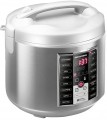The available operating modes of a multicooker provide a reliable indication of what you can typically expect when using the device. Among the main modes there are
warming up,
free mode,
express,
steaming,
stewing,
frying / deep frying,
boiling,
kneading dough, dough
proofing,
roasting,
simmering,
smoking,
baking,
sous-vide,
sterilization. More details about each of them:
— The free mode, as its name implies, gives users the freedom to manually adjust all the operating parameters of the device, such as temperature and cooking time. In more advanced models, it may even offer the option to program specific stages of cooking, such as initially applying high heat, gradually reducing it, and then maintaining the desired temperature for the finished product.
— Warming up. The pre-set program for warming up pre-cooked meals typically involves heating them at a relatively low temperature. It may also include a feature to maintain this temperature until the dev
...ice is manually turned off.
— Express. The Express mode offers a high-intensity heating setting in the cooking chamber, enabling faster cooking of various foods like cereals, legumes, scrambled eggs, dumplings, and pasta. It is specifically recommended for situations when time is limited. However, it is important to note that this mode is not suitable for baking items like pies, bread, or biscuits.
— Frying/deep frying. The ability to work in the frying mode assumes a high temperature and the presence of oil instead of water. Usually, the multicooker lid does not close in this mode.
— Boiling. The cooking mode in a multicooker rapidly brings liquid to a boil and then reduces the heat to maintain a gentle simmer. This mode is versatile and suitable for preparing a wide range of dishes, including boiled eggs, pasta, boiled vegetables (such as potatoes, beets, and carrots), soups, and beverages. Additionally, some multicookers offer a steam cooking option, where a special stand is used to elevate the food above the boiling liquid, allowing for steaming without direct contact.
— Roasting. The roasting mode in a multicooker involves applying high heat to the dish to create a crispy crust on the surface. While similar to baking, the roasting program has its distinct features. It may provide more intense heating or include a technique known as "short-term baking," where the product is prepared differently and then baked for a brief period (around 30-60 seconds) to achieve the desired crust formation.
— Stewing. This programme involves working at relatively low temperatures for a long time. It allows you to cook a fairly extensive range of dishes: soups, stews, some types of cereals, etc.
— Simmering. The simmer programme simulates cooking at the lowest intensity in a sealed container, similar to cooking in a classic oven. This method can be used in particular for roasts and cabbage rolls.
— Smoking. The smoking program in a multicooker typically enables traditional smoking by using smoke generated from burning wood chips. To ensure that regular dishes do not acquire a "smoked" flavor, a separate container is usually required. It's worth noting that not all multicooker models with a smoking program come equipped with additional containers.
— Baking. This programme is similar to the operation of a conventional oven: high temperature and closed (in contrast to the frying mode) lid. Suitable for flour baking, as well as various casseroles.
— Steaming. Steam cooking is recognized as a gentle cooking method and is commonly employed in dietary nutrition, including for children. To facilitate steam cooking, multicookers need to have a dedicated program as well as additional equipment such as baskets and a water tray, similar to traditional double boilers. These accessories may be included with the multicooker upon purchase.
— Dough kneading.The special dough preparation program in a multicooker eliminates the need for manual kneading, saving you from the tedious task. Typically, this function utilizes a separate bowl with a specialized spatula for the kneading process. It's important to note that different models may offer the preparation of various types of dough, and this information can be found in the detailed specifications.
— Proofing dough. The dough proofing mode involves the creation of optimal microclimatic conditions for raising yeast dough. In proofing mode, the multicooker heats up just above room temperature, typically around 30°C. The average proofing time for the dough is about 30 minutes.
— Sous-vide — a special technology of cooking in a vacuum. In sous-vide cooking, the food is first placed in a vacuum-sealed bag and then cooked slowly and at a low temperature, precisely controlled by the multicooker. This method involves processing the food at temperatures of up to 80°C for a period of 2-4 hours or even longer. Sous-vide technology ensures extremely even cooking of the food. It also offers the advantage of minimizing loss in weight and volume of the ingredients. Sous-vide is commonly used for preparing healthy and dietary dishes. The slow and vacuum-sealed heat treatment helps retain the juiciness and tenderness of the food, while the low temperature prevents the formation of a brown crust.
— Sterilization. Programme for sterilization of dishes used in the cooking of home preservation. Usually involves boiling for some time.
